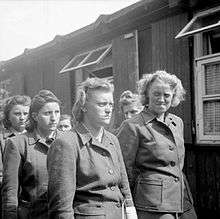Herta Bothe
| Hertha Bothe | |
|---|---|
 Herta Bothe, in Celle awaiting trial, August 1945 | |
| Born |
8 January 1921 Teterow, Mecklenburg-Schwerin |
| Occupation | Nazi concentration camp guard |
Herta Bothe (born 8 January 1921) was a Nazi concentration camp guard during World War II, imprisoned for war crimes after the capitulation of Nazi Germany. She was released early from prison on December 22, 1951 as an act of leniency by the British government.[1]
Life
Herta Bothe was born in Teterow, Mecklenburg-Schwerin. In 1938, at age seventeen, Bothe helped her father in his small Teterow wood shop, then worked temporarily in a factory, then as a hospital nurse. In 1939, Bothe was a member of the League of German Girls.
Guard at Ravensbrück-Stutthof
In September 1942, Bothe became the SS-Aufseherin camp guard at the Nazi German Ravensbrück concentration camp for women. The former nurse took a four-week training course and was sent as an overseer to the Stutthof camp near Danzig (now Gdańsk). There she became known as the "Sadist of Stutthof" due to her brutal beatings of prisoners.[2]
In July 1944, she was sent by Oberaufseherin Gerda Steinhoff to the Bromberg-Ost (Broming East) subcamp.[1]
On 21 January 1945, the 24-year-old Bothe accompanied a death march of women prisoners from central Poland to the Bergen-Belsen concentration camp near Celle. While en route to Bergen-Belsen, she and the prisoners stayed temporarily at Auschwitz concentration camp, arriving at Belsen between 20–26 February 1945.[1]
Guard at Bergen-Belsen

Once in the camp Bothe supervised a wood brigade of sixty women prisoners.[1] The camp was liberated on 15 April 1945.[3]
She is said to have been the tallest woman arrested, she stood 6' 3" (1.91 m). Bothe also stood out from other Aufseherinnen because, while most of the SS women wore black jackboots, she was in ordinary civilian shoes. The Allied soldiers forced her to place corpses of dead prisoners into mass graves adjacent to the main camp. She recalled in an interview some sixty years later that, while carrying the corpses, they were not allowed to wear gloves, and she was terrified of contracting typhus. She said the dead bodies were so rotten that the arms and legs tore away when they were moved. She also recalled the emaciated bodies were still heavy enough to cause her considerable back pain. Bothe was arrested and taken to a jail at Celle.[1]
At the Belsen Trial she was characterized as a "ruthless overseer" and sentenced to ten years in prison for using a pistol on prisoners. Bothe admitted to striking inmates with her hands for camp violations like stealing but maintained that she never beat anyone "with a stick or a rod" and added that she never "killed anyone."[4] Her contention of innocence was deemed questionable as one Bergen-Belsen survivor claimed to have witnessed Bothe beat a Hungarian Jew named Éva to death with a wooden block while another teenager stated that he saw her shoot two prisoners for reasons he could not understand.[5] Nevertheless, she was released early from prison on December 22, 1951 as an act of leniency by the British government.[1]
During a rare interview,[6] that was broadcast in 2009, Bothe (living in Germany under the name Lange) became defensive when asked about her decision to be a concentration camp guard. She replied:
Did I make a mistake? No. The mistake was that it was a concentration camp, but I had to go to it, otherwise I would have been put into it myself. That was my mistake.[7]
See also
References
- 1 2 3 4 5 6 "HERTA BOTHE, her life as a female Nazi "SS" concentration camp guard.". journals.aol.com. Archived from the original on February 28, 2008. Retrieved 31 July 2014.
- ↑ "Nazi women exposed as every bit as bad as Hitler's deranged male followers", The Daily Mail, 11 February 2009.
- ↑ Knoch, Habbo (ed) (2010). Bergen-Belsen: Wehrmacht POW Camp 1940–1945, Concentration Camp 1943–1945, Displaced Persons Camp 1945–1950. Catalogue of the permanent exhibition. Wallstein. ISBN 978-3-8353-0794-0.
- ↑ Konnilyn G. Feig, Hitler's Death Camps: The Sanity of Madness (New York: Holmes & Meier, 1981), p. 189.
- ↑ Wendy Adele-Marie Sarti, Women and Nazis: Perpetrators of Genocide and Other Crimes During Hitler's Regime, 1933-1945 (Palo Alto, CA: Academica Press, 2011), pp. 87-89.
- ↑ Dreykluft, Friederike (2004). Holokaust (TV mini-series). Germany: MPR Film und Fernsehproduktion.
- ↑ Raymond, Clare (21 November 2005). "Nazi She-Devils". Mirror.co.uk. Archived from the original on February 1, 2009. Retrieved 12 March 2016 – via Internet Archive.
External links
- "HERTA BOTHE, her life as an "SS" concentration camp guard". journals.aol.com. Archived from the original on February 28, 2008.
- Dreykluft, Friederike (2004). "HERTA BOTHE interview". Holokaust (TV mini-series). MPR Film und Fernsehproduktion.
- "Nazi She-Devils". Mirror. 21 November 2005. Retrieved 26 September 2012.